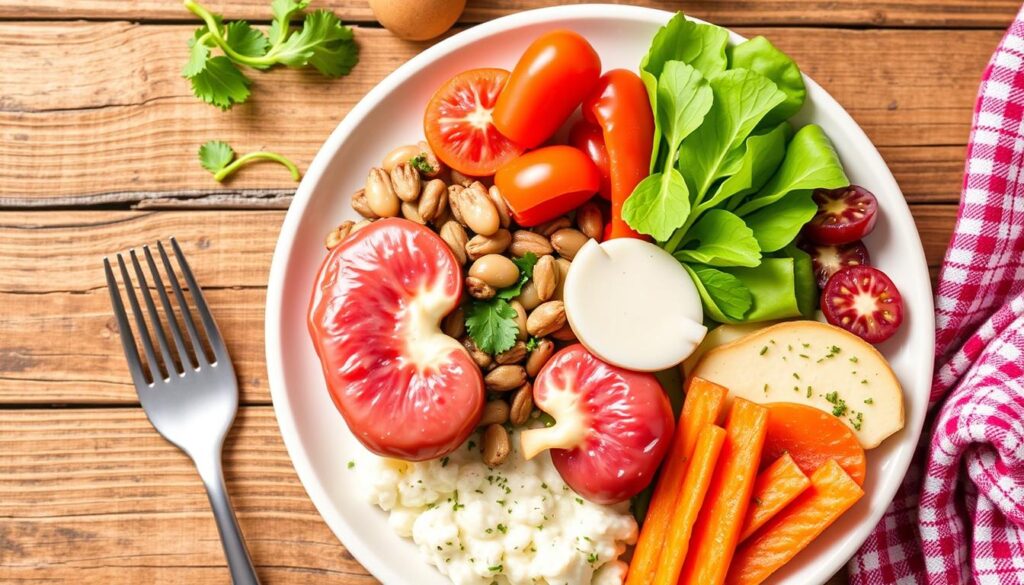Did you know Medicare and many private insurance plans cover dietitian visits for kidney disease? This shows how important a kidney-friendly diet is for managing chronic kidney disease (CKD). We’ll look at a personalized renal diet meal plan to slow kidney disease and boost your health.
Key Takeaways
- Proper nutrition is key for those with kidney disease. It helps prevent harmful mineral buildup and supports kidney health.
- A renal diet focuses on controlling sodium, protein, potassium, and phosphorus. This meets the unique needs of CKD patients.
- Meal planning and prep can make sticking to a kidney-friendly diet easier. You can enjoy tasty, healthy meals.
- Talking to a registered dietitian can help create a renal diet plan that fits your health needs and likes.
- Adding kidney-friendly recipes and snacks to your diet can make it enjoyable and lasting.
Table of Contents
Understanding the Importance of a Kidney-Friendly Diet
If you have chronic kidney disease, eating right is key. A special diet helps manage your condition and slow kidney damage. It limits sodium, potassium, and phosphorus to keep you healthy.
Why a Kidney-Friendly Diet is Crucial
A kidney-friendly diet is vital for those with chronic kidney disease. It controls blood pressure and diabetes, which harm kidneys. This diet ensures you get the nutrients you need, helps you stay at a healthy weight, and prevents infections.
It can greatly improve your life and slow kidney disease.
How a Renal Diet Can Slow Kidney Disease Progression
- A diet for managing chronic kidney disease should contain less than 2,300 milligrams of sodium each day to prevent high blood pressure.
- Protein intake should be carefully balanced, with 2-3 ounces of animal protein or 1/2 cup of plant-based protein per meal.
- Limiting phosphorus-rich foods, such as dairy, meat, and certain vegetables, can help prevent calcium depletion and bone weakness.
- Controlling potassium levels by choosing low-potassium fruits and vegetables can protect your heart health.
By following a kidney-friendly diet, you can manage your chronic kidney disease better. It improves your health and quality of life.
Creating a Personalized Renal Diet Meal Plan
Creating a kidney-friendly meal plan is key for managing chronic kidney disease (CKD). It’s best to work with a registered dietitian for this. They offer medical nutrition therapy that fits your needs, health, and diet preferences.
The dietitian will look at your current diet. Then, they’ll help you make a personalized renal diet with foods you like. This way, your meal plan will match your needs, making it easier to stick to.
The dietitian will help you with important parts of a kidney-friendly meal plan. This includes:
- Balancing protein intake to prevent muscle loss
- Controlling sodium levels to regulate blood pressure
- Monitoring potassium and phosphorus levels to prevent complications
- Incorporating heart-healthy foods to maintain strong blood vessels
By working with a dietitian, you’ll learn how to follow a renal diet. This diet can slow down your kidney disease and improve your health. A personalized plan is essential for long-term success.
Key Components of a Renal Diet Meal Plan
Creating a good renal diet meal plan means watching key parts like protein intake, sodium, potassium, and phosphorus. It’s important to balance these nutrients well. This helps people with kidney disease stay healthy and feel better.
Protein: Finding the Right Balance
Protein is important, but people with kidney problems need to watch how much they eat. Eating too much protein can hurt the kidneys. Eating too little can make skin, hair, and nails weak. Dietitians can figure out the right amount of protein for each person.
Controlling Sodium Intake
Keeping sodium levels low is key in a renal diet. Too much sodium can raise blood pressure and cause fluid buildup. Eating fresh foods, avoiding salt, and using herbs and spices can help keep sodium levels down.
Managing Potassium and Phosphorus Levels
It’s important to watch potassium and phosphorus levels in people with kidney disease. Foods like bananas, potatoes, and dairy products have too much of these minerals. They may need to be eaten less or not at all to avoid kidney problems.
By focusing on these key parts in a renal diet meal plan, people with kidney disease can manage their condition better. They can also improve their health and enjoy a better life.
Meal Planning Strategies for Renal Diet Success
Effective meal planning is key for a successful renal diet. Reading nutrition labels helps you understand serving sizes. This way, you can make better choices about how much to eat. Mindful eating, like eating slowly and stopping when you’re full, also helps control portions.
Preparing kidney-friendly meals ahead of time makes it easier to follow your diet. Using measuring tools helps you stick to your plan. Meal prep ensures you eat the right amounts, which is important for kidney health.
- Read nutrition labels to understand serving sizes and make informed choices about portion control.
- Practice mindful eating by eating slowly and stopping when full to help manage portion sizes.
- Prepare kidney-friendly meals in advance and use measuring tools to stick to your personalized renal diet plan.
| Meal Plan Details | Recommendations |
|---|---|
| Protein intake | 40-50 grams per day |
| Sodium intake | 1500 mg per day |
| Potassium intake | 1500 mg per day |
| Fluid intake | Less than 500 cc (2 cups or 16 ounces) per day |
By using these strategies, you can better manage your kidney-friendly meal prep. This will help you follow dietary guidelines for kidney disease management more effectively.
Delicious Renal Diet Meal Plan Recipes
Keeping a kidney-friendly diet doesn’t mean you have to give up taste or variety. The Kidney Kitchen offers a wide range of tasty and healthy recipes. These recipes meet the needs of those on a renal diet. They include everything from appetizers to main dishes and even desserts.
The renal diet meal plan has many different types of recipes. You’ll find appetizers, beverages, breads, desserts, main dishes, salads, sandwiches, sauces, side dishes, and soups. This variety means you can always find something you like and that fits your diet.
These recipes focus on using foods that are low in sodium, protein, potassium, or phosphorus. About 22% are low in sodium, 18% are low in protein, 30% are low in potassium, and 15% are low in phosphorus. This careful selection helps you manage your nutrients and keep your kidneys healthy.
Each recipe in the renal diet meal plan uses about 10.6 ingredients. It focuses on whole, unprocessed foods like beans, fruits, whole grains, vegetables, lean proteins, low-fat dairy, and nuts. It also has vegetarian (29%) and vegan (8%) options for different diets.
Exploring the Kidney Kitchen’s recipes lets you enjoy tasty meals that are good for your kidneys. Adding these recipes to your meal plan can help you eat well and support your kidney health.
Conclusion
Following a renal diet meal plan is key for managing chronic kidney disease. It helps slow the disease’s progress. Working with a registered dietitian is important. They help create a meal plan that fits your needs and preferences.
Strategies like portion control and managing sodium are crucial. They help balance nutrients like protein, potassium, and phosphorus. This keeps your kidneys working well and improves your health.
With the right meal plan and resources, you can manage your kidney disease better. This improves your life quality. Knowing the benefits of a renal diet and having a personalized plan empowers you.
Whether you’re in the early stages or facing more challenges, a tailored diet helps. It slows disease progression and lowers complication risks. By focusing on your kidney health, you can control your well-being and improve your life quality.
FAQ
What is a renal diet meal plan?
A renal diet meal plan is a special eating plan for kidney health. It limits sodium, potassium, and phosphorus. These nutrients can build up when kidneys don’t work right.
Why is a kidney-friendly diet crucial for those with kidney disease?
For those with kidney disease, a kidney-friendly diet is key. It helps slow disease progress, controls blood pressure and diabetes. It also ensures you get the nutrients you need for energy, muscle, and a healthy weight.
How can working with a registered dietitian help me create a personalized renal diet meal plan?
Working with a registered dietitian is very helpful. They create a meal plan that fits your tastes and needs. They look at your current diet and suggest healthy foods you’ll enjoy. They also help with any challenges in following a renal diet.
What are the key components of a successful renal diet meal plan?
A successful renal diet meal plan focuses on protein, sodium, potassium, and phosphorus. It’s important to get the right protein and limit sodium. Monitoring potassium and phosphorus levels is also key to avoid kidney disease complications.
What are some effective meal planning strategies for following a renal diet?
Effective strategies for a renal diet include reading labels and eating slowly. Avoid distractions while eating. Also, prepare meals in advance using measuring tools for portion control.
Where can I find delicious and nutritious renal diet recipes?
The Kidney Kitchen offers many tasty and healthy renal diet recipes. They cover different tastes and cuisines. This helps you enjoy tasty meals that support your kidney health.

Hey, I am Dr. Jenna Calloway. What you put into your body is what, intrinsically, makes the difference between success and burnout. Healthy food is fuel, and after years of working with high-performing professionals, I’ve put together nutrition strategies that are not only healthy but delicious and realistically easy to fit into your busy life. Whether you’re powering through a hectic day or looking to elevate your workouts, let me guide you on the path toward feeling your absolute best!

